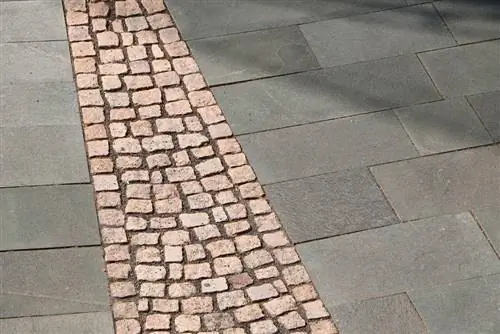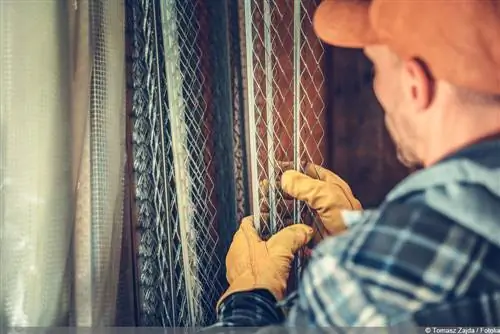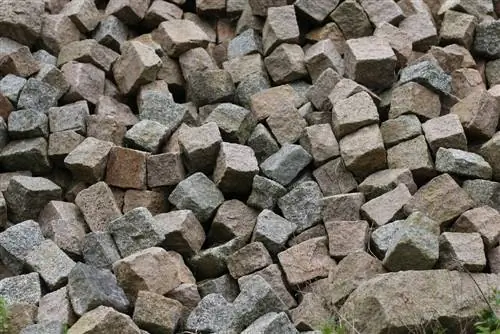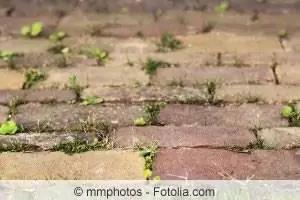- Author admin [email protected].
- Public 2023-12-17 03:39.
- Last modified 2025-01-24 12:45.
Over time, concrete slabs and paving stones become unsightly due to moss and weeds. Therefore, they should be cleaned regularly. But the longer the path and the larger the terrace, the more work is involved. But with a few tools such as vinegar, chlorine or soda, the plates are quickly clean again. To prevent severe contamination from occurring in the first place, it makes sense to carry out the procedure annually.
High-pressure cleaner
Even if it's quick, the high-pressure cleaner is not suitable for concrete slabs and paving. Because the concrete blocks have a surface texture that consists of many pores. These are absorbent and can go deep beneath the surface. This is an advantage in rainy and wet conditions because no film of water forms on the surface. But when it comes to cleaning, it is precisely this large-pored surface that is crucial. There are the following reasons that speak against a high-pressure cleaner for concrete slabs and paving:
- the high pressure can destroy the structure
- the water hits at certain points
- As a result, water can no longer be absorbed
- great risk of slipping in the long term
Tip:
The joints are often filled with sand or special mortar. These could also be washed out due to the high pressure of the high-pressure cleaner.
Joint scraper
Between the concrete slabs and paving stones there are joints in which weeds tend to spread because they have good conditions to grow here. Therefore, the first step is to scrape out the joints. The procedure is as follows:
- drive the scraper between the joints
- Remove grass, weeds and moss
- sweep the area well after scraping
Tip:
Especially when the area is large and many joints are infested with weeds, the work can be very difficult. Then a commercial weed killer can also help if you add it to the joints. But this chemical club should remain the exception as it can also have a negative impact on the rest of the garden.
Vinegar
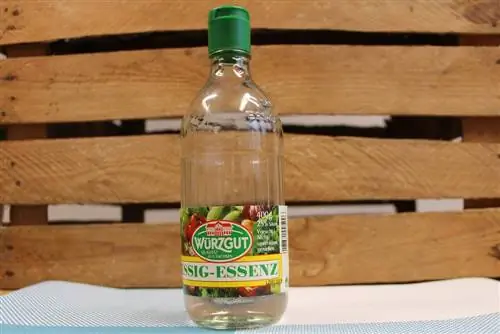
A mixture of vinegar and water can be used to combat green deposits on terraces and paths. Since vinegar is a very effective solution against weeds and moss, the joints do not need to be worked on beforehand. If the mixture is applied to the surface and between the joints, it will act on the roots of the weeds and they will die down on their own. When cleaning with vinegar, you should proceed as follows:
- Mixture of vinegar and water 1:1
- distribute over the entire area
- also put in the joints
- scrub well with a hard scrubber
- let it work well
- choosing a dry day for work
- when it rains the mixture is washed away
- rinse with a hose after two days
- The joints can also be rinsed out
- alternatively sweep loose weeds and moss with a broom
It is important that you only work on the stones to be cleaned and that the vinegar mixture is not spread into the adjacent garden. This can easily happen when scrubbing hard or later when rinsing with the hose. Therefore, meticulous and careful work is required here.
Tip:
If vinegar is used, there should be no lawn or garden bed next to the terrace or path. Because then the vinegar mixture could harm the flowers, vegetables, bushes or trees planted here as well as the adjacent lawn.
Chlorine
Chlorine can also help against moss and weeds. A commercially available chlorine cleaner is used for this, but it is not very environmentally friendly. It is important that the cleaner is diluted well with water and distributed over the entire area to be cleaned. A broom or a squeegee can be used for this. The mixture must now take effect for some time. Heavy stains can also be tackled with a broom or brush. But when cleaning, you should pay attention to the following:
- Chlorine is very aggressive
- Do not allow mixture to reach skin
- therefore wear sturdy shoes and gloves
- also long-sleeved, old clothes
- Stains may occur
- perform even cleaning
- otherwise you will get light spots
- Use the mixture only on the stones
- do not let it get into the adjacent garden
Tip:
Chlorine should only be used in extreme emergencies, for example if there is a very heavy moss infestation on a path or terrace, as it is very aggressive and could also harm the surrounding garden.
Soda
Soda is one of the most effective cleaners when it comes to moss and weeds on paving stones and concrete slabs. Soda is available in powder form in supermarkets or drugstores. A lye of water and soda is mixed from this by stirring 100 grams of soda into ten liters of boiling water. Depending on the area, more liquid is required. After the joints have been freed from weeds with a scratch, the cleaning proceeds as follows:
- Protect eyes and skin
- Soda is not completely safe
- So avoid splashes
- spread the soda water over the entire area
- work with a rubber squeegee or broom
- every area should be covered
- leave on for at least five hours
- Mixture does not need to be removed
Tip:
When working with the soda mixture, it should not rain, otherwise the mixture cannot work properly for five hours and may be washed away beforehand. To prevent it from drying out so quickly, an overcast day is ideal, as too much sun can cause the mixture to evaporate.
Removing oil from the plates
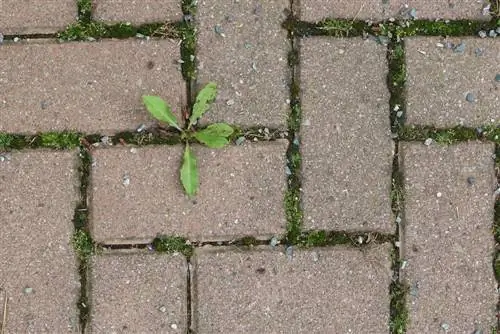
A garden path or terrace that is only covered in moss should not always be cleaned. There can also be more serious stains such as oil in garage driveways or on paving stones where cars are parked. These are usually stubborn and settle through the pores under the surface of the concrete slabs. But here too there are effective cleaning measures to get the stains out of the slabs and paving stones:
- bind fresh oil stain immediately
- Cat litter can help here
- S alt also binds the oil
- Let it take effect and pick it up carefully
- continue cleaning after removal
- Abandon lye from dishwashing liquid
- scrub lightly with a brush
- use dissolved tab for dishwasher
- also fat-dissolving
If there is an older stain, it must first be made liquid again and vacuumed up. This can also be done with detergent and cat litter. Then continue as described above.
Tip:
Acetone is also said to help remove an oil stain without leaving any residue.

